A New ctDNA Test for MRD Surveillance in Colorectal Cancer Patients
The personalized test is designed to help inform post-surgery adjuvant therapies in CRC patients.

A wave of new next-generation sequencing (NGS) techniques is fueling advances in cancer screening and detection. Liquid biopsy analysis of circulating tumor DNA (ctDNA) is enabling multiple biomarker or genomic profiling of specific cancer types and stages, while epigenetic methylome-based tests are making multi-cancer early detection a reality.
The power of NGS-based liquid biopsy analysis is also being harnessed to monitor minimal residual disease (MRD) following cancer detection and treatment. A recent study in Nature Medicine shows an association between ctDNA positivity and patient outcomes and prognosis in colorectal cancer, including helping identify patients who could benefit from adjuvant chemotherapy (ACT).1
Such approaches aim to clarify the need for adjuvant treatments such as post-surgical follow-up chemotherapy, potentially sparing patients from unnecessary pain and additional treatments. Furthermore, ctDNA MRD-based diagnostics may prove to play a critical role in cancer surveillance and in supporting long-term positive outcomes.
The Diagnostic Challenge
Colorectal cancer (CRC) is currently the third most prevalent cancer in the US, affecting over 100,000 new patients per year. 2 Recommended prescreening protocols by colonoscopy or stool-based tests are available as preventive measures and to minimize the risk of onset. If detected, the cancer stage is determined to establish the best course of action, which may include surgery to remove cancerous polyps by polypectomy, mucosal resection, or laparoscopic surgery. Advanced colorectal cancers can involve more invasive surgeries including partial colectomy, ostomy, and/or lymph node removal.
Post-surgery, most high-risk CRC patients are recommended for chemotherapy to remove any residual tumor cells and to prevent recurrence. Prior studies have shown that only 30 percent of post-surgical CRC patients benefit from chemotherapy. Up to 50 percent showed no signs of MRD following surgery, while approximately 20 percent experience disease recurrence despite post-surgical chemotherapy.3 Post-surgery, targeted drugs and immunotherapies may be administered or combined with chemotherapy regimens. However, there exists a paucity of diagnostics to inform the correct post-surgery course of action and whether chemotherapy is recommended or necessary. In the absence of definitive diagnostics for residual disease, it is challenging to decipher which patients will benefit from ACT and which will not.
The ctDNA Test for MRD Monitoring in CRC Patients
A new test called Signatera MRD is designed to help detect cancer recurrence at the earliest possible stage following treatment.4 Developed by Natera, a company focused on cell-free DNA testing for oncology, this test was implemented in the Nature Medicine study to assess MRD in CRC patients post-surgery during recovery or relapse responses.
The study examined pre- and post-surgical ctDNA in 1,039 patients with operable stage II-IV colorectal cancer1. Results of the analysis showed that identification of ctDNA at four weeks following surgery was linked with a higher risk of relapse, and was the most significant risk factor for CRC recurrence in stage II or III patients. In MRD-positive patients, 18 percent were shown to derive a significant benefit from ACT. Alternatively, 82 percent of MRD-negative patients showed no significant benefit from ACT treatment. Based on additional evidence, the study authors concluded that post-surgical ctDNA positively identified stage II/III patients who derived benefits from ACT.
Taken together, the results support the use of ctDNA testing to identify both those at risk of recurrence and those that will benefit from post-surgical ACT. As part of the observational GALAXY arm of the CIRCULATE-Japan study (UMIN000039205)5, the work represents one of the largest, most comprehensive prospective analyses of ctDNA in CRC. The National Comprehensive Cancer Network (NCCN) will likely include these findings in its 2023 CRC guide, fortifying current guidelines which have been in place since 2004 due to a lack of improved prognostic factors to guide treatment decisions.
How the Test Works
The Signatera MRD platform incorporates a custom-built assay, in which the unique mutation profile of the patient is built into the test. The patient tumor profile or signature can be identified and tracked to actively monitor for the presence or absence of disease over time.
The personalized assay is built from patient biopsied tissue or from post-surgical resected tissue. Whole exome sequencing is performed and combined with somatic and truncal variant information to increase sensitivity. Data is filtered for clonal hematopoiesis of indeterminate potential (CHIP) mutations to decrease false positives.
Once the assay is built, a blood sample is taken and analyzed for each time point during the designated adjuvant or surveillance program. Time points include: 1) directly following initial adjuvant therapy, 2) directly following surgery, 3) during MRD and recurrence monitoring, and 4) during treatment response monitoring following relapse.
Outlook
NGS analysis of liquid biopsy ctDNA is a rapidly growing technology space with several commercial products on the market and more under development. Some existing diagnostics focus on MRD monitoring in subsets of solid tumors. Others focus on genomic profiling of tumors to function as companion diagnostics. Emerging screening technologies aim toward multiple-cancer early detection.
The ctDNA MRD diagnostic technology described above fills an important void in post-surgical treatment and disease monitoring in CRC patients. This diagnostic can potentially protect patients from unnecessary adjuvant chemotherapy and other treatments following surgery, thereby relieving unnecessary toxicity and additional healthcare burden. In a broader context, this approach may have implications in addressing a range of cancers for which the benefits of adjuvant treatments are currently undefined.
References:
- https://www.nature.com/articles/s41591-022-02115-4
- https://www.cancer.org/cancer/colon-rectal-cancer/treating.html
- https://www.ncbi.nlm.nih.gov/pmc/articles/PMC7564362/
- https://www.natera.com/oncology/signatera-advanced-cancer-detection/
- https://www.onclive.com/view/circulate-japan-using-ctdna-to-guide-adjuvant-therapy-in-colorectal-cancer
Subscribe to Clinical Diagnostics Insider to view
Start a Free Trial for immediate access to this article